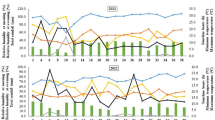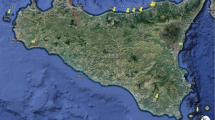Abstract
Damask rose (Rosa × damascena Herrm.) is the most important scented rose species, which some of its varieties are great importance for rose oil production. In the present survey, a total of 327 accessions of wild Damask rose from 21 geographically distinct regions of Iran were collected and transplanted in a protected conservation garden. After 2 years of plants establishment, phenotypic variation of accessions were evaluated using 36 morphological traits. High level of phenotypic variations was detected among the accessions especially desirable variations for commercial characters such as petal color, number of petals, and fragrance. The highest variability corresponded to petal number, leaf color, leaf stipule, and prickle shape. Flowering date varied from 08 May to 03 June. The petal number ranged between 17 and 159. The highest values for flower weight and petal weight were 5.67 and 4.61 g, respectively. Leaflet length ranged from 20.09 to 60.73 mm, while leaf width varied from 15.26 to 44.75 mm. Regression analysis indicated the importance of petal color, flowering date, and leaflet width/length in influencing floral scent. Dispersion diagram based on the first two principal components (40.86% of total variance) showed that the studied accessions were distributed into the plot. Some of the superior accessions were separated from others in scatter plot and characterized by the highest value of flower weight, petal weight, and petal number. In conclusion, the genotype collected will be useful for ex situ conservation and utilization in breeding programs of Damask rose.





Similar content being viewed by others
References
Andjelkovic V, Nikolic A, Kovacevic D, Mladenovic-Drinic S, Kravic N, Babic V, Srebric M, Jankulovska M, Ivanovska S, Bosev D (2018) Conserving maize in gene banks: changes in genetic diversity revealed by morphological and SSR markers. Chil J Agric Res 78(1):30–38
Babaei A, Tabaei-Aghdaei SR, Khosh-Khui M, Omidbaigi R, Naghavi MR, Esselink GD, Smulders MJM (2007) Microsatellite analysis of Damask rose (Rosa damascena Mill.) accessions from various regions in Iran reveals multiple genotypes. BMC Plant Biol 7:12
Cherri-Martin M, Jullien F, Heizmann P, Baudino S (2007) Fragrance heritability in hybrid tea roses. Sci Hortic 113:177–181
Cohen JI, Williams JT, Plucknett DLP, Shands H (1991) Ex situ conservation of plant genetic resources: global development and environmental concerns. Science 253(5022):866–872
DeWalt SJ, Denslow JS, Hamrick JL (2004) Biomass allocation, growth, and photosynthesis of genotypes from native and introduced ranges of the tropical shrub Clidemia hirta. Oecologia 138:521–531
Dhyani D, Singh S (2014) Potential wild rose germplasm of Western Himalayas—conservation, evaluation and registration. Indian J Agr Sci 84:229–235
Ercisli S (2005) Rose (Rosa spp.) germplasm resources of Turkey. Genet Resour Crop Evol 52(6):787–795
Farooq A, Aslam Khan M, Ali A, Riaz A (2011) Diversity of morphology and oil content of Rosa damascena landraces and related Rosa species from Pakistan. Pak J Agric Sci 48(3):177–183
Fereidoonfar H, Salehi-Arjmand H, Khadivi A, Akramian M (2018) Morphological variability of sumac (Rhus coriaria L.) germplasm using multivariate analysis. Ind Crops Prod 120(15):162–170
Gudin S (2000) Rose: genetics and breeding. Plant Breed Rev 17:159–189
Guterman I, Shalit M, Menda N, Piestun D, Dafny-Yelin M, Shalev G, Bar E, Davydov O, Ovadis M, Emanuel M, Wang J, Adam Z, Pichersky E, Lewinsohn E, Zamir D, Vainstein A, Weiss D (2002) Rose scent: genomics approach to discovering novel floral fragrance-related genes. Plant Cell 14(10):2325–2338
Karami A, Khosh-Khui M, Salehi H, Saharkhiz MJ (2012) Correlation between anthocyanin and essential oil content of Damask rose (Rosa damascena Mill.). J Med Plants By-Prod 1:3–6
Kaul K, Karthigeyan S, Dhyani D, Kaur N, Sharma RK, Ahuja PS (2009) Morphological and molecular analyses of Rosa damascena × R. bourboniana interspecific hybrids interspecific hybrids. Sci Hortic 122(2):258–263
Khadivi A (2018) Phenotypic characterization of Elaeagnus angustifolia using multivariate analysis. Ind Crops Prod 120:155–161
Khadivi A, Ayenehkar D, Kazemi M, Khaleghi A (2018) Phenotypic and pomological characterization of a pomegranate (Punica granatum L.) germplasm collection and identification of the promising selections. Sci Hortic 238:234–245
Khadivi-Khub A, Jafari HR, Zamani Z (2013) Phenotypic and genotypic variation in Iranian sour and duke cherries. Trees 27:1455–1466
Khadivi-Khub A, Etemadi-Khah A (2015) Phenotypic diversity and relationships between morphological traits in selected almond (Prunus amygdalus) germplasm. Agrofor Syst 89:205–216
Khaleghi A, Khadivi A, Zonneveld BJM (2018) Morphological variations among and within species of wild tulip (Tulipa L.) from Iran. Genet Resour Crop Evol 65:2241–2266
Kiani M, Zamani Z, Khalighi A, Fatahi R, Byrne DH (2008) Wide genetic diversity of Rosa damascena Mill. germplasm in Iran as revealed by RAPD analysis. Sci Hortic 115(4):386–392
Kiani M, Zamani Z, Khalighi A, Fatahi Moghadam MR, Kiani MR (2010) Collection and evaluation of morphological diversity of Damask rose genotypes of Iran. Iran J Hortic Sci 41(3):223–233 (in Persian)
Kokkini S, Papageorgion VP (1998) Constituents of essential oils from Rosa damascena growing wild in Greece. Planta Med 54:59–60
Kumar R, Sharma S, Sood S, Agnihotri VK (2013) A gronomic interventions for the improvement of essential oil content and composition of Damask rose (Rosa damascena Mill.) under western Himalayas. Ind Crops Prod 48:171–177
Liu W, Shahid MQ, Bai L, Lu Z, Chen Y, Jiang L, Diao M, Liu X, Lu Y (2015) Evaluation of genetic diversity and development of a core collection of wild rice (Oryza rufipogon Griff.) populations in China. PLOS One 10(12), e0145990. doi:https://doi.org/10.1371/journal.pone.0145990
Mikanagi Y, Saito N, Yokoi M, Tatsuzawa F (2000) Anthocyanins in flowers of genus Rosa, sections Cinnamomeae (= Rosa), Chinenses, Gallicanae and some modern garden roses. Biochem Syst Ecol 28(9):887–902
Mohammadi R, Khadivi A, Khaleghi A, Akramian M (2019) Morphological characterization of Prunus microcarpa Boiss. germplasm: implications for conservation and breeding. Sci Hortic 246(27):718–725
Nakamura N, Fukuchi-Mizutani M, Miyazaki K, Suzuki K, Tanaka Y (2006) RNAi suppression of the anthocyanidin synthase gene in Torenia hybrida yields white flowers with higher frequency and better stability than antisense and sense suppression. Plant Biotechnol 23:13–17
Nakamura N, Katsumoto Y, Brugliera F, Demelis L, Nakajima D, Suzuki H, Tanaka Y (2015) Flower color modification in Rosa hybrida by expressing the S-adenosylmethionine: anthocyanin 3′,5′- O-methyltransferase gene from Torenia hybrid. Plant Biotechnol 32:109–117
Oka N, Ohishi H, Hatano T, Hornberger M, Sakata K, Watanabe N (1999) Aroma evolution during flower opening in Rosa damascena Mill. Z Naturforsh 54:889–895
Potter JR (1977) Leaf area partitioning as an important factor in growth. Plant Physiol 59:10–14
Rehder A (1940) Manual of cultivated trees and shrubs, 2nd edn. MacMillan, NewYork
Rusanov K, Kovacheva N, Vosman B, Zhang L, Rajapakse S, Atanassov A, Atanassov I (2005) Microsatellite analysis of Rosa damascena Mill. accessions reveals genetic similarity between genotypes used for rose oil production and old Damask rose varieties. Theor Appl Genet 111(4):804–809
Shuhua Y, Ning G, Hong G (2016) Morphological and AFLP-based genetic diversity in Rosa platyacantha population in eastern Tianshan mountains of Northwestern China. Hortic Plant J 2(1):55–60
Singh S, Dhyani D, Nag A, Sharma RK (2017) Morphological and molecular characterization revealed high species level diversity among cultivated, introduced and wild roses (Rosa sp.) of western Himalayan region. Genet Resour Crop Evol 64:515–530
Tabaei-Aghdaei SR, Babaei A, Khosh-Khui M, Jaimand K, Rezaee MB, Assareh MH, Naghavi MR (2007) Morphological and oil content variations amongst Damask rose (Rosa damascena Mill.) landraces from different regions of Iran. Sci Hortic 113:44–48
Tanaka Y, Sasaki N, Ohmiya A (2008) Plant pigments for coloration: anthocyanins, betalains and carotenoids. Plant J 54:733–749
Widrlechner MP (1981) History and utilization of Rosa damascena. Econ Bot 35(1):42–58
Wu J, Zhang C, Chen J, Cai C, Wanga L, Fu D, Ou L (2016) Morphological diversity within litchi (Litchi chinensis Sonn.) based on leaf and branch traits. Sci Hortic 207:21–27
Yang L, Ren J, Wang Y (2014) Chemical investigation of volatiles emitted from flowers of three varieties of Damask rose cultivated in Beijing. Hortic Environ Biotechnol 55(6):524–530
Zuker A, Tzfira T, Ben-Meir H, Ovadis M, Shklarman E, Itzhaki H, Forkmann G, Martens S, Neta-Sharir I, Weis D, Vainstein A (2002) Modification of flower color and fragrance by antisense suppression of the flavanone 3-hydroxylase gene. Mol Breed 9:33–41
Zvi MMB, Negre-Zakharov F, Masci T, Ovadis M, Shklarman E, Ben-Meir H, Tzfira T, Dudareva N, Vainstein A (2008) Interlinking showy traits: co-engineering of scent and colour biosynthesis in flowers. Plant Biotechnol J 6:403–415
Acknowledgements
The present study was funded by Arak University, Iran (grant number 97/2323).
Author information
Authors and Affiliations
Corresponding authors
Ethics declarations
Conflict of interest
The authors declare that they have no conflict of interest.
Additional information
Publisher's Note
Springer Nature remains neutral with regard to jurisdictional claims in published maps and institutional affiliations.
Rights and permissions
About this article
Cite this article
Khaleghi, A., Khadivi, A. Morphological characterization of Damask rose (Rosa × damascena Herrm.) germplasm to select superior accessions. Genet Resour Crop Evol 67, 1981–1997 (2020). https://doi.org/10.1007/s10722-020-00954-z
Received:
Accepted:
Published:
Issue Date:
DOI: https://doi.org/10.1007/s10722-020-00954-z




